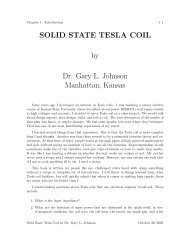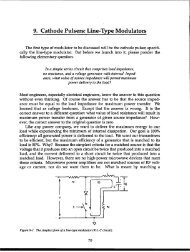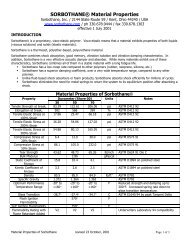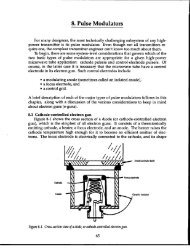3.6M north10.pdf - Dean-O's Toy Box
3.6M north10.pdf - Dean-O's Toy Box
3.6M north10.pdf - Dean-O's Toy Box
You also want an ePaper? Increase the reach of your titles
YUMPU automatically turns print PDFs into web optimized ePapers that Google loves.
160 High-Power Microwave-Tube Transmitters<br />
charge is increasingly intolerable. (Remember what we used to pick up on the<br />
AM car radio when we drove near high-tension wires, especially on a foggy<br />
day?)<br />
We have discussed the fact that the removal of charge from a capacitor bank,<br />
no matter how large, will result in its terminal voltage being smaller than it was<br />
before the charge-removal interval, or pulse. In the interpulse interval, therefore,<br />
it will be necessary to replace the charge removed during the pulse. In the<br />
discussion of line-type modulators, much was made of the issue of recharging<br />
without incurring energy loss if the current was limited by resistance. Is there a<br />
similar concern when it comes to replacing partial discharge? The answer is not<br />
nearly as much. The reason for this is shown graphically in Fig. 10-6, which plots<br />
energy removed from the dc power supply, energy transferred to the capacitor<br />
bank, and energy dissipated in series resistance versus the per-unit amount that<br />
the capacitor is discharged each pulse. (This graph assumes that the resistance is<br />
small enough so that the RC time-constant is less than approximately 1/3 of the<br />
minimum interpulse interval, assuring that the capacitor will recharge to approximately<br />
the power-supply terminal voltage between pulses.) If we look at<br />
full discharge, or per-unit discharge of unity, the results are familiar. The perunit<br />
capacitor energy transfer and resistor energy dissipation are both unity, and<br />
the per-unit energy removed from the power supply is 2. Notice, however, that<br />
only the energy removed from the power supply is a linear function of per-unit<br />
discharge voltage. For less-than-unity per-unit discharge, energy transferred to<br />
the capacitor falls off less rapidly than dissipation in the resistor. Therefore, the<br />
efficiency of energy transfer increases as AV/Vdecreases.<br />
The reason for this can be seen if we note the change in charge during a pulse<br />
of current, AQ = CAV, and the change in capacitor energy, AW = AQ, times average<br />
capacitor voltage during discharge, which can be expressed as<br />
~Avx<br />
V+ V–AV<br />
2<br />
or<br />
~vAv _ C(AV)2<br />
The energy removed from the power supply during recharge is AQ times the<br />
power supply voltage, which can be expressed as CAV x V. Recharging efficiency<br />
is the ratio of energy transferred to the capacitor to the energy removed from the<br />
power supply, or<br />
2“<br />
+Av-a=,<br />
——— l[AV)<br />
CVAV 2V”







